The Techné Sparrowhawk II stands out in the inexpensive chronograph market. It is a well-executed aviator with sharp styling, great build quality and the added perk of an interesting movement at its heart. At $269 one does not usually expect something unique, but Techné manages to pull it off. The aviator market is fairly saturated, with offerings from brands across the price spectrum, from Timex to Steinhart to Bell & Ross. It’s a look that does not change very much from brand to brand, but the Sparrowhawk II achieves something refined, that is clearly an aviator, yet not derivative. Combine this with the Meca-Quartz chronograph within and you can begin to see how the Sparrowhawk II is more that just an affordable watch, it’s genuinely innovative.
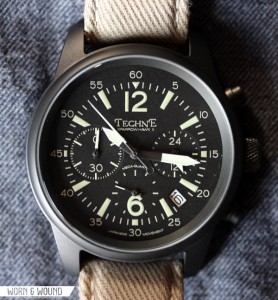 Case: PVD Coated 316L Surgical Stainless Steel
Case: PVD Coated 316L Surgical Stainless Steel
Movement: Seiko VK63 Meca-Quartz Chronograph
Dial: Black w/ Off-White indexes
Lens: Mineral w/ AR coating
Case Back: Screwdown
Strap: Khaki Canvas
Water Res.: 100m
Dimensions: 41.5mm
Thickness: 11.7mm
Lug Width: 20mm
Crown: 7mm screwdown
Warranty: 1 year
The Seiko VK63 Meca-Quartz Chronograph movement is an uncommon and interesting movement that while not history making, is one of the first in this price range. Essentially, it’s a quartz movement where instead of having separate motors controlling the chrono registers, there is a single motor powering a gear train that connects the hands. The end result is a quartz movement with many of the benefits of a mechanical chronograph, such as 1/5th second sweeps and instant snap-back reset (watch our video for a demonstration). Other benefits over traditional quartz mechanicals are greater energy efficiency, as it does not require battery power to reset, stiffer and more tactile pushers and the ability to set the time while the chronograph is running.
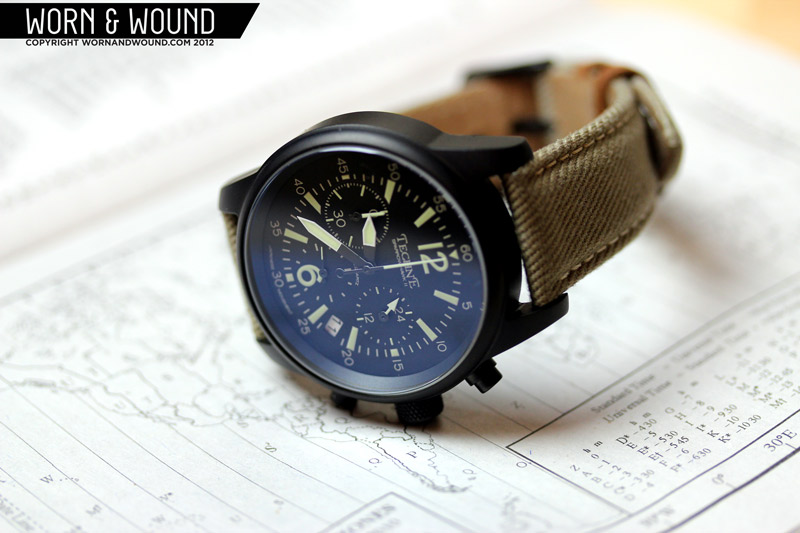 Meca-Quartz movements were actually first developed in the late 80’s- early 90’s by Jaeger LeCoultre (the leCoultre 630) and Frédéric Piguet (the Piguet 1720). As you would expect from these brands, these movements were used in luxury watches, such as this $4500 dollar IWC and were massively complex. A $4500 quartz is a hard sell even for such reputable brands, so the Meca-Quartz revolution never exactly took off. The Seiko VK63, VK67 and VK83 movements now bring this innovative concept to the very affordable range, and given the benefits this style of movement offers, I bet it is something you will see more of. Sure, there are some inexpensive mechanical chronographs out there, such as the Poljot 3133 or the SeaGull ST19, but those are less posed for mass-market consumption, and frankly, while being fully mechanical, they don’t offer little perks like a 24-hour subdial.
Meca-Quartz movements were actually first developed in the late 80’s- early 90’s by Jaeger LeCoultre (the leCoultre 630) and Frédéric Piguet (the Piguet 1720). As you would expect from these brands, these movements were used in luxury watches, such as this $4500 dollar IWC and were massively complex. A $4500 quartz is a hard sell even for such reputable brands, so the Meca-Quartz revolution never exactly took off. The Seiko VK63, VK67 and VK83 movements now bring this innovative concept to the very affordable range, and given the benefits this style of movement offers, I bet it is something you will see more of. Sure, there are some inexpensive mechanical chronographs out there, such as the Poljot 3133 or the SeaGull ST19, but those are less posed for mass-market consumption, and frankly, while being fully mechanical, they don’t offer little perks like a 24-hour subdial.
Moving on to the rest of the watch, the 41.5mm x 11.7mm case of the Sparrowhawk II is well proportioned and sits very comfortably on the wrist. It was clearly designed to be large for practical reasons, i.e. have a large and clear dial, but was not over-sized for fashion. The distance from lug-to-lug is 49.5mm, which is also modest, and stays within the boundaries of my wrist, which is on the smaller size. The result is a watch that I am sure would fit well on wrists of most sizes, has a sporty stance, but does not dominate one’s arm.
 This is aided by the “aviation grade” matte black PVD finish over sandblasted 316L steel, which Techné refers to as “cockpit” black. It is a superbly matte and even finish, that is dark as night and very attractive. I am a fan of PVD watches and I can tell you that not all PVD is created equal; sometimes it has a slight sheen to it, and other times it doesn’t read as deep black… The Techné, however, is a true and satisfying PVD. The coating continues onto the chrono pushers, the crown and the case back. The etching on the case back, which indicates various information such as water resistance and reference number, is executed very cleanly and has an interesting effect on the PVD. The areas that are etched have a slight gloss and an almost deeper black, making them standout and easy to read.
This is aided by the “aviation grade” matte black PVD finish over sandblasted 316L steel, which Techné refers to as “cockpit” black. It is a superbly matte and even finish, that is dark as night and very attractive. I am a fan of PVD watches and I can tell you that not all PVD is created equal; sometimes it has a slight sheen to it, and other times it doesn’t read as deep black… The Techné, however, is a true and satisfying PVD. The coating continues onto the chrono pushers, the crown and the case back. The etching on the case back, which indicates various information such as water resistance and reference number, is executed very cleanly and has an interesting effect on the PVD. The areas that are etched have a slight gloss and an almost deeper black, making them standout and easy to read.
The deep black of the case is matched perfectly with the matte black dial. This is critical in the overall look of the watch, as the even flow from case to dial eliminates any visual distractions from the hands, indexes and sub-dials. The driving design motivation of most pilot and aviation watches is to have at-a-glance legibility from large lumed markers and large hands, even on dials with an abundance of information. The Sparrowhawk II achieves this with various design features and a solid sense of composition. First, the dial is broken up into 4 main components.
 There is the primary index with large 12 and 6 markers, large trapezoidal hour markers, individual minute markers and, on the outer perimeter, 5 – 60 in increments of 5. The 12, 6 and trapezoidal markers are all lumed. Just looking at these elements, there are few interesting things going on. One: the trapezoidal markers are narrower towards the inside of the dial, leading the eye towards the center of the watch. Two: the large 12 and 6 create a quick reference point for the hour, are visually striking given their size and refer to classic aviator style. Three: the 5 – 60 index on the perimeter sits in a sort of quiet space, giving them maximum visibility.
There is the primary index with large 12 and 6 markers, large trapezoidal hour markers, individual minute markers and, on the outer perimeter, 5 – 60 in increments of 5. The 12, 6 and trapezoidal markers are all lumed. Just looking at these elements, there are few interesting things going on. One: the trapezoidal markers are narrower towards the inside of the dial, leading the eye towards the center of the watch. Two: the large 12 and 6 create a quick reference point for the hour, are visually striking given their size and refer to classic aviator style. Three: the 5 – 60 index on the perimeter sits in a sort of quiet space, giving them maximum visibility.
The 3 sub-dials all have distinct looks that suit their individual functions. At the 3 position is a 24-hour or military time dial that reflects the design of the primary 12-hour index, with large 24 and 12 markers, smaller markers for the individual hours and medium lumed markers every 6 hours. At the 6 position is the small seconds that is part of the primary time. This dial is fairly sparse, with only small markers every five seconds and no numerals. While this lacks precision, the whole function is basically vestigial given the 1/5th second precision of the chronograph. Visually speaking, it does add necessary weight to the bottom half of the dial. Lastly, at the 9 position is the 60 minute counter of the chronograph function. This dial has large 0 and 30 numerals, and markings for all 60 minutes in 3 sizes: large lumed markers every 10 minutes, medium every 5 and small for the rest. Both the military time dial and 60-minute counter have light debossing, which ever so slightly breaks up the matte dial and gives added visual weight to the subdials.
Clearly, there is a lot going happening on the dial, yet the use of many different sized markers and dials of varying density make it easy to focus on a single piece of information. Aiding this is one of my favorite details of the watch, which are the 6 hands. Like the dials themselves, each hand is unique for its function. The main hour and minute hands are Roman sword styled and the largest on the watch. They standout and are proportioned well to the dial. The military time hand is a relatively large arrow that is distinct amongst the hands. I believe this is designed to refer to the ability to use the military time dial as a compass by means of referencing the sun, which is described in the watch’s manual. The small seconds hand is thin and half lumed. It basically looks like a moving marker, creating a minimal amount of distraction. The chrono seconds and minutes are both stick shaped with lume on the majority of their forms and clearly appear as grouping.
 The dial also has a date window between the 4 and 5-hour markers that displays the date with black text on a white surface. I have seen discussion where this is a slight point of contention, as the white disrupts the otherwise matte black dial. While it does break up the uniform look, it is easy to read, which is the goal. Overall, the design of the dial achieves the aviator style well and is simply very attractive. The greenish off-white markers have a slightly aged feel, not as much as a watch with “old Radium” lume has, but enough to give the watch a vintage feel. The lume itself glows a bright green, and is fairly strong after charging, but not very long lasting.
The dial also has a date window between the 4 and 5-hour markers that displays the date with black text on a white surface. I have seen discussion where this is a slight point of contention, as the white disrupts the otherwise matte black dial. While it does break up the uniform look, it is easy to read, which is the goal. Overall, the design of the dial achieves the aviator style well and is simply very attractive. The greenish off-white markers have a slightly aged feel, not as much as a watch with “old Radium” lume has, but enough to give the watch a vintage feel. The lume itself glows a bright green, and is fairly strong after charging, but not very long lasting.
My one qualm with the dial is more conceptual. I think the layout is well thought out, clear and attractive, but it is lacking one feature that I would expect. The dial does not indicate 1/5th second intervals for the chronograph. While this is not a necessary or standard feature to mechanical chronos, I feel that the lack of that index somewhat undermines the use of the Mecha-Quartz movement. It’s not a deal killer by any means. Frankly, I don’t know when I would need that level of precision for my own practical use, but being practical is not really the driving force in buying a watch in today’s market.
 The build quality of the watch is very high, which is great to see in a sub $300 dollar watch. The quality can be seen the PVD finish, the crisp printing on the dial, the beautiful strap and the feel of the crown and pushers. The screwdown crown measures 7mm x 3mm and is a straight cylinder with a machined diamond pattern along the side. The tactile pattern has a great feel, and the action of the crown is very smooth in both unscrewing and setting the time. The chrono pushers have a confidence inspiring stiffness to them, which is brought by the mechanical chronograph function. They also depress with a loud click, which is very satisfying.
The build quality of the watch is very high, which is great to see in a sub $300 dollar watch. The quality can be seen the PVD finish, the crisp printing on the dial, the beautiful strap and the feel of the crown and pushers. The screwdown crown measures 7mm x 3mm and is a straight cylinder with a machined diamond pattern along the side. The tactile pattern has a great feel, and the action of the crown is very smooth in both unscrewing and setting the time. The chrono pushers have a confidence inspiring stiffness to them, which is brought by the mechanical chronograph function. They also depress with a loud click, which is very satisfying.
As I mentioned in the Initial Impressions, the 20mm khaki strap is perfectly suited to the look of the watch. The color works well with the black case, adds to the vintage/military aesthetic and makes the markers on the dial pop. It is also a very comfortable strap with nice details, such as light brown leather reinforcement around the sizing holes, light brown loops, leather-esque backing (not sure if it genuine as it is unmarked) and a PVD buckle. I have also tried an olive green nylon NATO, which works well. One thing to note is that the lugs are fairly short, and the spring bars are close to the body of the watch. While I was able to get a nylon NATO through, it was tight, and I doubt a thick leather strap would work well.
The Sparrowhawk II is a very exciting watch. At $269 it really is in a class of it’s own as nothing feels like it has been neglected to save costs. The aviator aesthetic is perfectly achieved, and in my opinion better executed than usual. Every design feature was driven by a purpose and then aesthetically refined, from the 41.5mm case to the 6 hands. The end result is balance, legibility and good looks. The VK63 movement within adds a lot of value, even if it is inexpensive, as it adds function, precision and a tactile response that is atypical for quartz movements. On top of that, the watch comes with the best designed and most useful manual iI have yet to see. Frankly, I see the Sparrowhawk II as a potential model of what affordable watches by small brands could become in the post ETA world, so to speak, and I’m looking forward to what Techné will offer in the near future.









 Featured Videos
Featured Videos





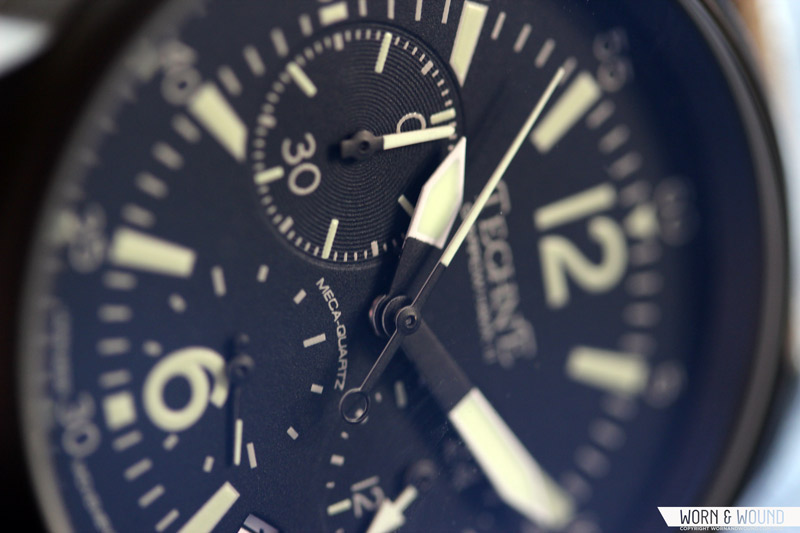
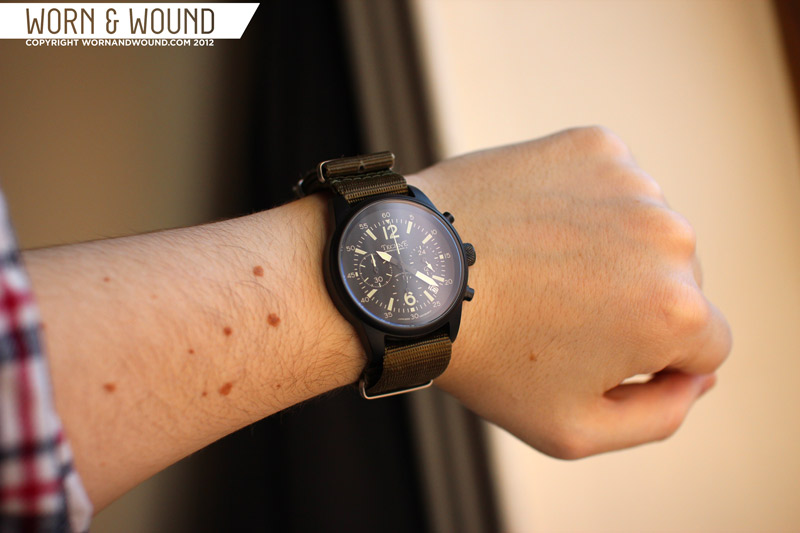
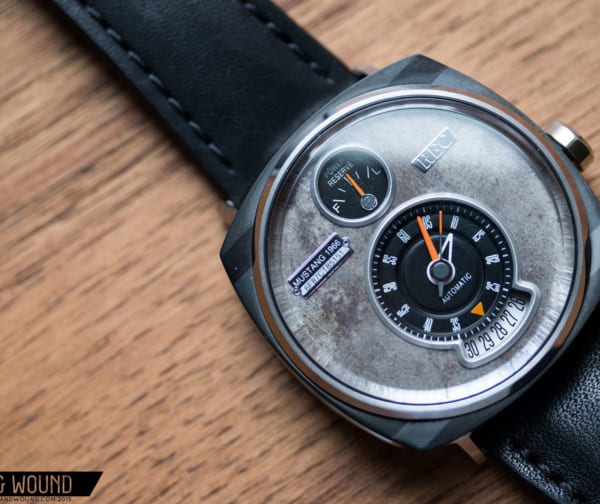


Another great review!
The watch looks good and no doubt will opperate well, for me, and I know its a little niggle, and at this price, very petty. Why did they not do more with the packaging? No matter what I pay for a watch I want it to feel special as soon as it arrives at my door. It looks like an old glasses case!!
Hi Phillip,
While the glasses case is not particularly exciting, I do think the presentation of the cardboard outer box and field manual are superb. Furthermore, I am actually more likely to keep and use the simple eyeglasses case in the future for travel and such as it is very sturdy and space saving. Giant elaborate boxes are awesome initially, but not practical in the long run. Either way, I’m glad you liked you the review, and thanks for the comment!
Looks really sharp, and for a low price as well. I like the khaki strap.
Watch noob here.. So this one’s a semi-automatic, meaning it won’t be a good idea to go running in this one would it?
Hi JB,
It’s not a “semi-automatic”, it’s semi-mechanical. There is no rotor winding a mainspring or anything like that. Rather, it has a mechanical gear train running the chronograph function. Typically speaking, quartz watches are more durable since there are less moving parts in the mechanism, namely, no balance wheel. This is one of the components of mechanicals that can get broken when a watch is dropped, bumped into something, or under heavy exertion. That being said, I can’t speak to the actual durability of the Seiko VK63 movement. I don’t think running would damage it, but i’d avoid contact sports.
zach,
where can i get this? Love the site man!
the techne website has them for over 400
Hi RS,
It appears that the Sparrowhawk II is currently sold out. The 400+ model you see there is the Sparrowhawk 1 which has a Seagull 1901 manual wind chronograph in it. I’m sure given the success of this watch that Techne will release more in the near future.
-Zach
Is it possible to get that strap anywhere? I looked on the website and they dont have it. Thanks
“Is it possible to get that strap anywhere? I looked on the website and they dont have it. Thanks”
8 straps when you include colour options available on their site – http://technewatches.biz/
Write to them if you still cant see what you want?
Anyone already bought this watch? I’ve made an order for de Sparrowhawk 1 last Monday, but I didn’t get any response yet.
Late to commenting on this review, but I am into the Sparrowhawk as a great upgrade from the Seiko SNDA65. The Sparrowhawk is smaller (a bonus), and has a similar look. Thanks for the review – to the sales forums!